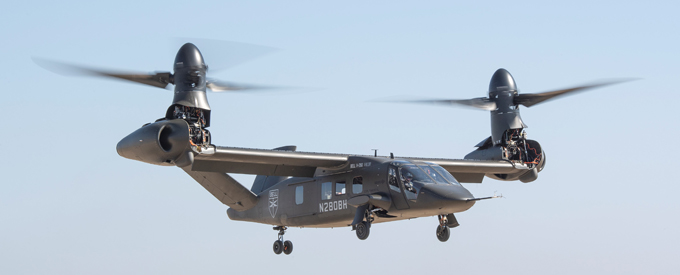2020-02-02
Bell Flies V-280 Autonomously
During a recent media demonstration, Bell confirmed that it’s V-280 Valor tilt-rotor demonstrator flew autonomously for the first time on December 18, 2019 at the company’s Arlington, Texas, U.S., facility. Bell is readying for an Army downselect decision in March to continue forward in the Future Long Range Assault Aircraft (FLRAA) programme.
Ryan Ehinger, Bell’s programme manager for the V-280, said the technology demonstrator aircraft performed the full range of autonomous flight requirements during the test, including autonomous takeoff, conversion into cruise mode, precision navigation to various waypoints, loiter manoeuvres, conversion into vertical-takeoff-and-landing mode, and landed autonomously.
After two-years of successful flight demonstrations, the Bell V-280 Valor continues to showcase new capabilities to show how the aircraft meets the challenges of future flights. The aircraft has flown more than 150 hours through multi-sortie test days and numerous public demonstrations to deliver data and inform requirements for the FLRAA programme.
“The V-280 and flight test programme teams’ performances have gone above and beyond expectation,” said Keith Flail, vice president of Advanced Vertical Lift Systems at Bell. “Our team of defence-aerospace technology and manufacturing experts demonstrated the ability to deliver a high-performance aircraft on schedule that will revolutionise U.S. military vertical lift capability. We are very proud of this track record and look forward to competing for the U.S. Army FLRAA programme.”
In 2019 alone, Team Valor and the V-280 programme team delivered performance milestones. Flight testing did not simply focus on demonstrating engineering manoeuvres. The team understands that the V-280 must be suitable for use in multi-domain operations as well. To that end, the V-280 has integrated the Lockheed Martin Pilotage Distributed Aperture System (PDAS) mission equipment package and has flown operationally focused tests showing fast rope deployment options. Looking forward, testing will include additional mission equipment package integration, sling load tests and a demonstration of autonomous flight.
Bell also continues to analyse and test options to improve future fleet affordability and sustainment lifecycle cost. The team has undertaken initiatives to address cost-drivers inherent in operational aircraft by employing the latest digital technologies to optimise affordability throughout the fleet’s lifecycle.
In addition to performance achievements, the V-280 has also continued to be recognised for excellence from independent organisations. For example, the National Aeronautic Association nominated the V-280 for the prestigious Collier Trophy and Aviation Week has recognised the V-280 with a Laureate Award for the second consecutive year.
These results show that the U.S. Army’s joint multi-role (JMR) technology demonstrator (TD) programme has been a great example of government-industry partnership. The success of the JMR TD effort offers the Army an opportunity to leverage technologies proven over the past six years to inform a programme of record and get new capabilities fielded in line with the Army’s modernisation strategy. The V-280 demonstrates that close collaboration between government and industry can deliver transformational capabilities in a rapid and sustainable process.
“Bell is committed to our customers. Our talented employees are innovators who have reimagined how vertical lift can help modernise the Army with the V-280 Valor. We are proud of what the V-280 and Team Valor have achieved in six short years and look forward to building on our success to bring next generation capability to the warfighter in the coming years,” continued Flail.
As the competition for the U.S. Army’s FLRAA moves forward, Bell and Team Valor continue to set the pace.
"We are committed to equipping the Army's first unit with the Future Long Range Assault Aircraft no later than 2030," said Colonel David Phillips, the Program Executive Office for Aviation's Project Manager for FLRAA. "This effort will provide critical risk mitigation and inform the programme of record as we pursue the material solution to meet the Army's aviation modernisation priority."
The U.S. Army initiated the FLRAA programme in 2019 to develop a successor to the Sikorsky UH-60 Black Hawk utility helicopter as part of the Future Vertical Lift programme. The UH-60, developed in the early 1970s, has been in service since June 1979. Like the UH-60, FLRAA variants would also serve United States Special Operations Command and the United States Marine Corps.
Under the existing JMR-TD programme, the Army has been gathering data from flying prototype designs that could fill the FLRAA role. The Army posted a request for information (RFI) in April 2019, which was intended to identify interested manufacturers.
According to the RFI, the Army plans to bring the FLRAA into service in 2030, in anticipation of retiring the UH-60 after a 50-year life.
Future Vertical Lift is the Army's third modernisation priority with FLRAA as a critical combat system needed to prevail in future wars by enabling a "leap-ahead" in speed, range, lethality, survivability, and reach to find, fix, and finish enemy threats and subsequently exploiting open corridors with significantly more capable air assault and Medevac capabilities.
Reference Text/Photo:www.bellflight.com


No Comments